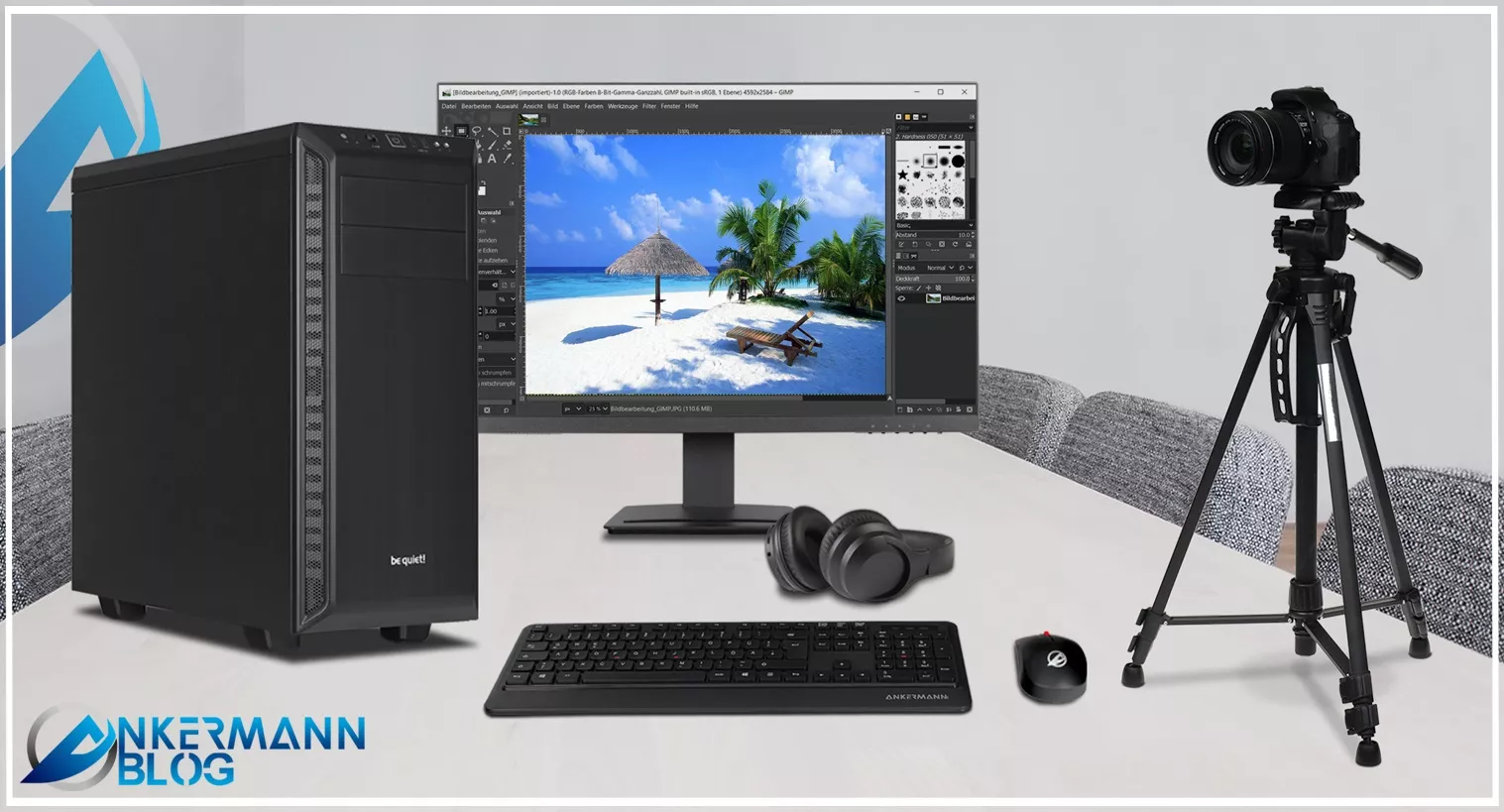AMD Ryzen 7 9800X3D – Next-generation gaming power
RX 9070 and RTX 5070 - Finally, competition in the mid-range graphics card market
HDMI 2.2 - More bandwidth and new features
Creator PCs for image and video editing
Warum sollte ich mich um meine PC-Sicherheit sorgen?
HDMI 2.2 - More bandwidth and new features
.webp)
HDMI 2.2 - More bandwidth and new features
More bandwidth: up to 96 Gbit/s
Stable refresh rates and high resolutions are important not only for gaming. A brief introduction to current and outdated transmission technology from computer to monitor.
HDMI 2.2 doubles the bandwidth of HDMI 2.1 from 48 Gbps to 96 Gbps. This enables higher resolutions and refresh rates. However, there's a caveat: new cables are required to take advantage of these improvements over the previous version.
The HDMI 2.2 standard was created to meet the increasingly demanding requirements of modern displays and content. Its higher bandwidth enables resolutions such as 8K at 240 Hz and even 12K at 120 Hz. It will likely be decades before these specifications are fully utilized. The current HDMI 2.1 standard transmits 4K at 120 Hz. This is sufficient even for high-end gaming. HDMI has traditionally been heavily used in the consumer market, but its higher bandwidth makes HDMI 2.2 attractive for professional applications, such as digital signage, cinema, and similar applications.
New Features
The new HDMI specification brings several improvements. Thanks to increased bandwidth, higher resolutions and refresh rates are possible. This is made possible by a new cable specifically designed for HDMI 2.2. The technology offers particular benefits for content creators in TV, film, and gaming. It offers application possibilities across multiple platforms.
HDMI 2.2 is a further development and eliminates the weaknesses of its predecessor. HDMI 2.1 had a maximum bandwidth of 48 Gbps. This is more than sufficient for normal applications, but 4K resolution at 240 Hz without compression requires a theoretical bandwidth of 55 to 69 Gbps. In comparison, the current DisplayPort version 2.1 enables up to 80 Gbps. However, since the DisplayPort standard is used almost exclusively by PC end users, these significantly higher transfer rates are primarily limited to PC monitors.
Improved synchronization of picture and sound
Another highlight of HDMI 2.2, besides the increased bandwidth, is the Latency Indication Protocol (LIP), which optimizes audio and video synchronization. This protocol is useful for complex system configurations such as AV receivers or soundbars to ensure precise tuning and minimize lip-sync issues. However, the most significant latency issues have already been resolved with HDMI 2.1 and eARC.
To utilize the full range of the new HDMI 2.2 standard, new cables are required. These will be available in 2025. To utilize the full range of features, both the source and the display device must support the new standard. Currently, there are no devices that support HDMI 2.2.
For consumers, this means that current HDMI 2.1 devices are still sufficient for the time being, as most content and displays do not yet fully exploit the capabilities of HDMI 2.1.
The HDMI standards CEC, ARC and eARC
- CEC: The Consumer Electronics Control standard provides cross-component control functions for entertainment electronics. This allows multiple devices to be operated with a single remote control. All devices can go into standby mode together. Playing a movie on the DVD player automatically turns on the TV, and much more.
- ARC: The Audio Return Channel transmits audio signals back to the TV or monitor. This allows you to connect a receiver, soundbar, or other playback devices.
- eARC: The enhanced Audio Return Channel is the further development of ARC with more bandwidth and speed.
The competing standards DP 2.1 and HDMI 2.1
What do the two popular standards DisplayPort and HDMI offer in their version 2.1?
DisplayPort
DisplayPort 2.1 is the latest version of the DisplayPort standard developed by the Video Electronics Standards Association (VESA). This standard offers several improvements over previous versions. For gamers, DisplayPort offers the advantage of no licensing fees. Therefore, many graphics cards have one expensive HDMI port and three DisplayPort ports.
- More bandwidth: DisplayPort 2.1 offers a high bandwidth of up to 80 Gbit/s, enabling a higher data transfer rate.
- Higher resolutions and refresh rates: Thanks to the increased bandwidth, DisplayPort 2.1 supports higher resolutions and refresh rates, including 8K at 60 Hz and 4K at 240 Hz.
- HDR: The standard supports High Dynamic Range (HDR) for improved image quality.
- Backward compatibility: DisplayPort 2.1 is backward compatible with previous versions, so older devices can still be used.
- Improved support for VR and AR: DisplayPort 2.1 provides better support for virtual reality (VR) and augmented reality (AR) displays, resulting in an improved user experience.
Overall, DisplayPort 2.1 offers significant improvements in image quality, data transfer, and compatibility compared to its predecessor, making it an ideal choice for modern monitors and graphics cards.
HDMI 2.1 is a significant evolution of the HDMI standard and offers numerous improvements over older versions:
- Increased bandwidth: HDMI 2.1 supports a maximum bandwidth of 48 Gbps, enabling higher resolutions and refresh rates.
- Support for 8K and 10K: The standard supports resolutions up to 8K at 60 Hz and even 10K at lower refresh rates.
- Dynamic HDR: HDMI 2.1 supports dynamic HDR, meaning brightness, contrast, and colors can be optimized for each scene or even each frame.
- eARC (Enhanced Audio Return Channel): eARC offers improved audio quality and supports advanced audio formats such as Dolby Atmos and DTS:X.
- Variable Refresh Rate (VRR): VRR reduces lag and stuttering, which is especially beneficial for gaming.
- Quick Media Switching (QMS): QMS eliminates delays that can occur when switching between different media sources.
- Auto Low Latency Mode (ALLM): ALLM allows the display to automatically switch to the lowest latency mode. This is especially useful for gaming. Gamers appreciate this mode.
There are also older standards that don't fully utilize the capabilities of current displays and are therefore not recommended for use with them. These include DVI and VGA.
The DVI standard or rather: The DVI standards
DVI means Digital Visual Interface and is an interface specification developed for transmitting video data from a computer to a display, such as a monitor or projector. The DVI standard was introduced in 1999 by the Digital Display Working Group (DDWG). Gradually, the one standard evolved into three.
Some important features of the DVI standard are:
- Signal transmission: DVI can transmit both analog and digital signals, making it versatile.
- Different connection types: There are three main types of DVI connectors:
- DVI-A (analog)
- DVI-D (digital)
- DVI-I (integrated, supports both analog and digital signals)
- Resolutions and refresh rates: DVI supports various resolutions and refresh rates. DVI-D and DVI-I, in their dual-link versions, can achieve relatively high resolutions such as 2560x1600 at 60 Hz.
- Steckertypen: DVI connectors are available in different versions, depending on whether they support single-link or dual-link. Dual-link DVI connectors have more pins and can therefore transmit higher data rates.
Although DVI is less common today and has often been replaced by newer standards like HDMI and DisplayPort, it is still widely used in older devices and certain professional applications. Its versatility and ability to transmit high-quality video signals keep it relevant.
The VGA-Standard
VGA, oder Video Graphics Array, is a video transmission standard introduced by IBM in 1987. VGA was the dominant standard for connecting computers to monitors and projectors for many years and has played a significant role in computer history. PC gaming and the VGA standard share common roots, exploring the limits of what was possible even back then.
Some important features of the VGA standard are:
- Signal transmission: VGA transmits analog video signals via a 15-pin D-Sub cable.
- Auflösung: The original VGA specification supported a resolution of 640x480 pixels at 60 Hz. Today's VGA connectors can also support higher resolutions, depending on the quality of the cable and the device.
- Color depth: VGA supports 16 colors at a resolution of 640x480, or 256 colors at a lower resolution of 320x200.
- Steckertyp: VGA uses a 15-pin D-Sub connector, also called DE-15. This connector is characterized by its trapezoidal shape and three rows of pins.
- compatibility: VGA is widely used and supported by many older and some newer devices. Although newer standards such as HDMI and DisplayPort have largely replaced VGA, VGA is still widely used, particularly in older devices and certain industrial applications.
VGA has proven to be a robust and reliable standard and has played a central role in computer graphics for decades.
The USB-C Standard
Unlike other standards, USB-C version 3.1 and higher can transmit not only video and audio signals, but also data and electrical power. Version 3.2 Gen 2 supports transfer rates of up to 10 Gbps.
USB-C ports specified according to USB 2.0 or USB 3.0 cannot transmit video and audio signals. This is only possible starting with version 3.1.
In so-called Alternate Mode, in addition to USB 2.0 and USB 3.1 data, DisplayPort, HDMI, MHL, and audio signals can also be transmitted. DisplayPort and HDMI signals are used for image and audio transmission, while MHL signals are intended for the connection between mobile phones and computers.
The prerequisite for this function is that BOTH USB-C ports support Alternate Mode.

_1.webp)

